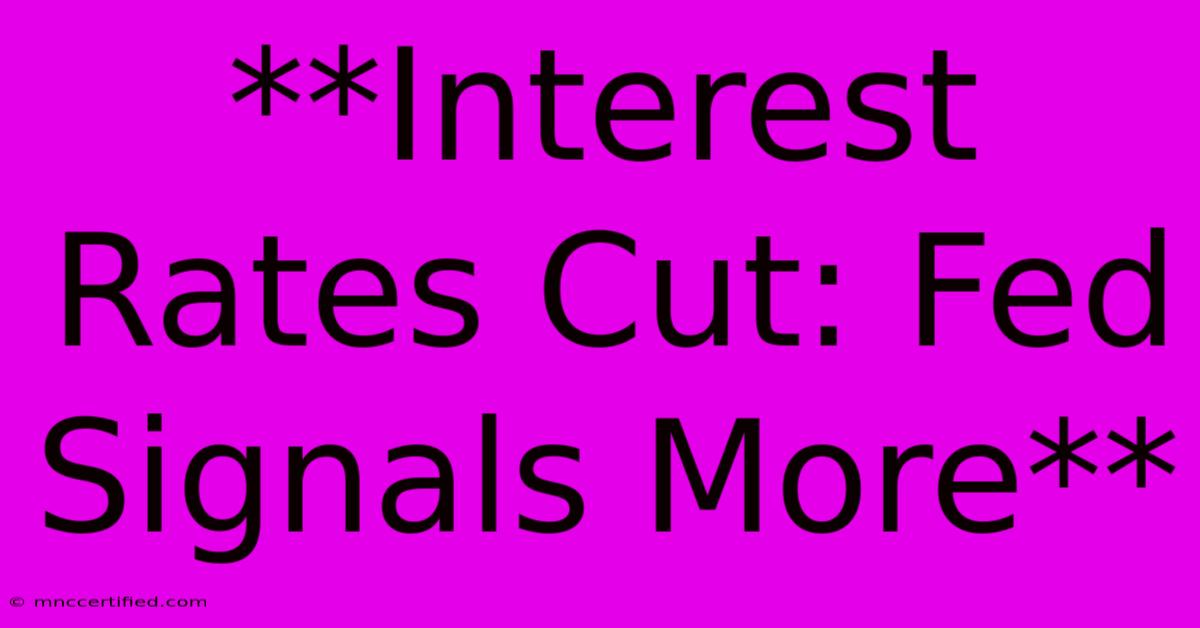**Interest Rates Cut: Fed Signals More**

Table of Contents
Interest Rates Cut: Fed Signals More Easing Ahead
The Federal Reserve has cut interest rates for the first time since 2008, signaling a shift in monetary policy as concerns about global economic growth intensify. The move, announced on July 31, 2019, saw the benchmark federal funds rate lowered by a quarter of a percentage point to a range of 2.00% to 2.25%.
This decision, although expected by many market analysts, represents a significant departure from the Fed's recent stance of gradual tightening. It signals a recognition that the U.S. economy is facing headwinds, including slowing global growth, trade tensions, and uncertainty surrounding Brexit.
What Does This Mean for Consumers and Businesses?
For consumers:
- Lower borrowing costs: The rate cut could make it cheaper to borrow money for major purchases like homes, cars, and student loans. This could boost consumer spending and help stimulate economic growth.
- Potential for lower interest rates on savings accounts: While the Fed's rate cut directly affects the federal funds rate, it can influence other interest rates across the economy, including those on savings accounts.
For businesses:
- Cheaper access to capital: The lower borrowing costs could encourage businesses to invest in expansion and new projects, potentially creating jobs and boosting economic activity.
- Potential for increased investment: Lower interest rates can make borrowing more attractive for businesses, leading to increased investment and economic growth.
What's Next for Interest Rates?
The Fed's statement accompanying the rate cut suggests that more easing may be on the horizon. The central bank indicated it would "act as appropriate to sustain the expansion" of the economy, implying that further rate cuts are possible if economic conditions warrant them.
Factors Influencing Future Rate Decisions
The Fed's future decisions on interest rates will be heavily influenced by various factors, including:
- Global economic growth: The Fed is closely monitoring global economic trends and the potential for spillover effects on the U.S. economy.
- Trade tensions: The ongoing trade war with China poses a significant risk to the U.S. economy, and the Fed will consider its impact on growth and inflation.
- Inflation: The Fed aims to keep inflation at around 2%, and will be watching for signs of rising or falling price pressures.
- Labor market conditions: The strength of the labor market is another key indicator the Fed considers when setting interest rates.
Conclusion
The Fed's decision to cut interest rates marks a significant shift in monetary policy, reflecting concerns about the global economic outlook. While the rate cut could provide a short-term boost to the economy, the future path of interest rates will depend on evolving economic conditions and the Fed's assessment of risks to the U.S. economy.
Key takeaways:
- The Fed cut interest rates for the first time since 2008, signaling a shift in monetary policy.
- This move could lead to lower borrowing costs for consumers and businesses, potentially boosting economic activity.
- The Fed's statement suggests further easing is possible if economic conditions deteriorate.
- The future path of interest rates will be influenced by global economic growth, trade tensions, inflation, and labor market conditions.
Keywords: Interest rates, Federal Reserve, Fed, rate cut, monetary policy, economic growth, global economy, trade tensions, inflation, labor market, borrowing costs, consumer spending, business investment.

Thank you for visiting our website wich cover about **Interest Rates Cut: Fed Signals More**. We hope the information provided has been useful to you. Feel free to contact us if you have any questions or need further assistance. See you next time and dont miss to bookmark.
Featured Posts
-
Pressure Mounts On Scholz To Stabilize German Government
Nov 08, 2024
-
Bank Of England Rate Cut Financial Implications
Nov 08, 2024
-
The Day Of The Jackal 2024 A Stylish Review
Nov 08, 2024
-
Bailey Addresses Ddg Son Photo Controversy
Nov 08, 2024
-
Pacific Coastal General Insurance Agency
Nov 08, 2024